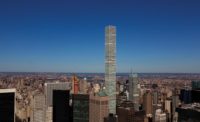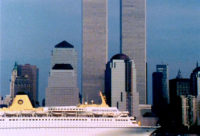Like such other world capitals as London or Shanghai, New York City has been witnessing a disturbing boom in supertall skyscrapers. These extremely tall residential and office towers have been made possible by new technical developments. For example, residential construction benefits from high early-stage strength of high-performance reinforced concrete and pumpability coupled with slip and climb formwork, which saves money by reducing the construction time considerably. Where taller buildings used to be confined to commercial and financial sectors of the city, a new generation of supertall luxury apartment buildings have begun to infiltrate low and mid-rise residential areas. Several such towers now line West 57th Street in Manhattan, giving spectacular views of Central Park from the top apartments.
They can easily shoot up above their surroundings because the floor area ratio (FAR) zoning regulations do not necessarily limit height. Now with the ability to build higher with such ease, luxury apartments are being planned with ceilings that are twice the height of conventional standard apartments: a new 30-story apartment building today could be the equivalent height of a 60 story, older neighbor with the same allowable floor area, but much lower ceiling heights. Many of these new supertalls contain only one or two units per floor. None of them, of course, include affordable housing.
While real estate economists say the trend to residential supertalls may be waning, because of over-supply of multi-million dollar units and the threat of a slowing economy, they are still some extraordinary transactions: last week, hedge fund tycoon Kenneth Griffin broke the record price for an apartment by paying $238 million for a penthouse on Central Park South in a not-yet-completed tower designed by RAMSA. More supertalls are under construction and others are in planning stages. On the Upper West Side of Manhattan, one example, on West 66th Street, is 775 feet high. Designed by Snøhetta and SLCE for Extell Development, it is shorter than the supertall qualifying height of 984 feet given by Council on Tall Buildings and Urban Habitat but it is nearly twice the height of the tallest neighbors and a bit taller than the lofty Time Warner Center at Columbus Circle.
Recently announced are plans for an office tower just off Fifth Avenue on East 51st Street, which would rise to 1,556 feet, taller than the Empire State Building. Gensler is the design architect and Adamson Associates is the architect of record for developer Harry Macklowe, who built the new residential tower 432 Park Avenue by Rafael Viñoly. That 1,396 foot-high chimney-like structure used five double-height mechanical floors evenly spaced within the tower to gain more height, because mechanical spaces do not count as floor area under current rules. The new project, called Tower Fifth, in a mostly commercial area, is just north of St. Patrick’s Cathedral—which likely sold much of its 1.2 million square feet of transferrable air-rights to make this project possible. Although there are no height restrictions for this major insertion in Midtown, Macklowe may have to ask for waivers or special permits for approval. So its future may not be guaranteed.
The problem with all this upward push on the skyline is its impact on density and character throughout the city. Tall New York has always been balanced by low New York. Many low-rise residential neighborhoods have maintained their appeal precisely because they are a counterpoint to the height and darkness of mid-town and the financial district. It is past time for New York’s Department of City Planning (DCP) to reassess unlimited height districts and “soft” sites (under-developed existing lots). The city needs to re-evaluate where supertall buildings would be suitable, and where they would be destructive to the existing neighborhoods.
And while a new plan is formulated to bring existing zoning rules up-to-date with the reality of New York today, the City Council should mandate a moratorium on any “as-of-right” supertall project. Both the Department of Buildings and City Planning need to evaluate fire and life safety, as well as the impact of this building type on adjacent properties with regard to straining infrastructure. It should also consider view corridors, the negative effects of wind tunnels, and, most important, shadows cast across parks, playgrounds and open space.
In addition, the term “as-of-right” needs to be redefined, along with tougher regulations regarding air rights transfers and lot mergers. Any proposed new tower development that far exceeds the average adjacent building height should be submitted to the DCP and the appropriate Community Planning Board for public review and comment. Already the New York City Council has been in discussions with the Department of City Planning and the Department of Buildings; a proposed text amendment to the NYC Zoning Resolution limiting the height and number of voids (eg. mechanical space) is due to be certified soon. Additional amendments relating to other loop holes, such as the use of stilts to increase heights, are being considered as well.
Meanwhile, local activists have already joined with some elected officials and neighborhood residents to resist more supertalls. Landmark West! a non-profit preservation organization, led a fight against the Snøhetta’s West 66th Street project with some success: The Department of Buildings recently issued a Notice of Intent to Revoke [the Permit] for the new building that will potentially reduce its height. A major problem is that the mechanical space on the 18th floor is 161 feet high. This location in the lower portion of the project pushes up allowable square footage for occupied space as high the developer wants.
Currently there is no plan in place, no mechanism for control of the ad hoc placement of supertalls in residential neighborhoods adjacent to public parks and playgrounds. There are areas where supertalls may be appropriate, such as the downtown Financial District, or in some areas beyond Manhattan. But city planners need to canvas and map established residential neighborhoods, to determine where this new architecture is best located. Building too tall and unchecked close to public parks risks permanently altering, even destroying the key neighborhoods that are still the bed-rock of a livable and vibrant New York.



